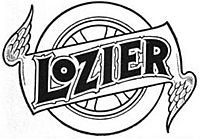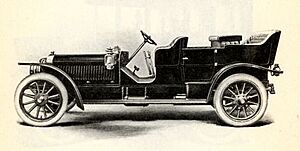Lozier facts for kids
 |
|
| Automobile Manufacturing | |
| Industry | Automotive |
| Genre | Touring cars, limousines |
| Fate | Bankrupted |
| Founded | 1900 |
| Founder | Henry Abram Lozier |
| Defunct | 1915, 1918 |
| Headquarters | , |
|
Area served
|
United States |
|
Key people
|
George R. Burwell, John G. Perrin, Harry A. Lozier |
| Products | Vehicles Automotive parts |
|
Production output
|
(1898, 1901, 1905-1918) |
The Lozier Motor Company was a company that made very fancy and expensive cars in the United States. These cars were known as "brass era" vehicles because of the many shiny brass parts they had. The company built cars from 1900 to 1918. Their first factory was in Plattsburgh, New York. Later, in 1910, they moved their main operations to Detroit, Michigan.
Contents
History of Lozier Cars
Starting the Company
The Lozier Motor Company was started by Henry Abram Lozier. He was born in Indiana and used to make sewing machines and bicycles. After selling his bicycle business, Lozier moved to Plattsburgh. There, he started making engines for boats. In 1900, he decided to get into the car business.
Henry Lozier passed away in 1903. His son, Harry Lozier, then took over the company.
Expensive and Fast Cars
Lozier cars were known for being very luxurious. For a while, they were the most expensive cars made in the United States. For example, in 1910, a Lozier car could cost anywhere from $4,600 to $7,750. That was a huge amount of money back then!
The company moved its main factory to Detroit in 1910. In 1911, a Lozier car entered the very first Indianapolis 500 race. The driver, Ralph Mulford, finished second. Many people watching the race thought his Lozier car had actually won.
Lozier cars were also known for their speed. On March 19, 1911, a Lozier ad claimed a special record. A standard 49 horsepower (hp) model, driven by Teddy Tetzlaff, set a world record. It drove 100 miles (160 km) in just 1 hour, 14 minutes, and 29 seconds.
The company also developed a special braking system. It used pressurized water to cool the brake drums. This meant their brakes were very strong and "impossible to burn out."
Challenges and Changes
Over time, more companies started making luxury cars. This created more competition for Lozier. In 1913, Frederick C. Chandler, who was Lozier's main car designer, left the company. He started his own company called the Chandler Motor Company.
Chandler's new company made cars that looked similar to Lozier's. However, they sold them for a much lower price. Several other important people from Lozier also left with Chandler. This loss of talented staff made it very hard for Lozier to recover.
New Models and Decline
At an event called the Los Angeles Motordrome in 1913, Lozier showed off new cars. They introduced the 88 hp Big Six. This car had electric headlights. The touring car and roadster versions cost $5,000. The limousine and landaulette models cost $6,500.
They also introduced the 52 hp Light Six Metropolitan. This car had an electric starter and lights. The touring car and runabout versions were $3,250. The coupe was $3,850, and the limousine was $4,450.
Lozier only made a few thousand cars during its time. This was because they focused on a very specific, high-end market. Production was highest in 1912, when they made 600 cars.
In 1914, Lozier tried to make cars for a wider audience. They offered a four-cylinder car that cost $2,000. But this new car did not sell well. The company's money problems continued to get worse.
After a failed attempt to join with the Ford Motor Company, Lozier declared bankruptcy in 1915. They tried to reorganize and keep making cars for a few more years. However, production stopped completely by 1918.
Images for kids



